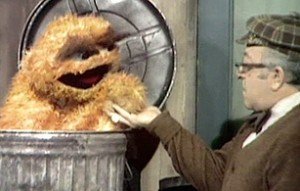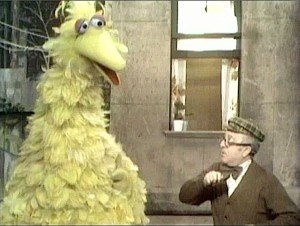Sesame Street Ep #56
Today’s episode of Sesame Street aired on January 26th, 1970, about 2 months after the previous one, and, if you’d like to view it yourself, is available on iTunes and Netflix under the name “An Orange Grouch and a Green Grover”. I thought it would be cool to watch an episode a little further into the run, to see how things developed since the premiere. In some ways, it’s still very much the same show. The plotting and connective tissue is still rudimentary at best, however there are a number of linked sketches which, at least at the start, hold this episode together a bit better than the last, although that falls away as it proceeds.
Unlike the first episode, this one actually opens with a Muppet, Oscar (who is still orange but now has hands!), introducing the hour, and features the Muppets much more prominently than the premiere. We no longer need the humans to bring us into the Sesame Street world. We’re already comfortable there. Furthermore, Oscar speaks right to us through the camera, grumbling, “You again? Why are you always hanging around here?” How many children’s shows today would start with a grumpy character telling us to leave, Ferris Bueller style? Shortly afterwards, a very friendly Mr. Hooper passes by–again, all of his misanthropy from the pilot seems to have been given to Oscar–and Oscar asks him whether he makes ice cream sundaes. “I make the best ice cream sundaes the world has ever known,” he brags. Which works out perfectly for Oscar, because, shockingly, he wants one!
And then, if all of the polyester outfits didn’t remind us we were in 1970, the fact that Oscar calls the 30 cents the sundae will cost him “a lot of money” certainly does! Oscar counts out 3 dimes and hands them to him, which smoothly transitions to a “Jazz No. 3” cartoon (the Sesame Street cartoon series with spies wearing numbered trenchcoats), and then we’re back to Oscar and Mr. Hooper. No awkward introduction or explanation of the cartoon a la the pilot, just trusting us to get how they’re linked. Muchos gracias, Sesame Street. And then comes the kicker, where Oscar finally tells Mr. Hooper what kind of sundae he wants. Naturally, it’s a dessert fit for a Grouch: a baked bean sundae with chocolate ice cream, topped with chopped pickles, whipped cream, and a radish on top! A horrified and nauseated Mr. Hooper brings a handkerchief to his mouth before finally concluding, “Well, it’s his 30 cents.”
Then we quickly zip to the “Song of 3” we saw in the previous episode, with Jim Henson juggling, and then back to Mr. Hooper, who is regaling Big Bird with the story of the horrendous sundae Oscar has requested. “That’s terrible,” the still-derpy Big Bird responds. “Everyone knows a black bean sundae’s no good unless you make it with strawberry ice cream!” Ba dum dum siss. This is pretty much a pitch perfect example of a Big-Bird-before-he-was-Big-Bird type gag. Sure, it’s funny, but it doesn’t really make any sense. Like the “lay an egg” joke in the first episode, why would Big Bird ever have tried a black bean sundae, something clearly only a Grouch could enjoy? This is merely a “Big Bird is a dunce” joke. He says something silly and dumb because he’s silly and dumb. Later on, Sesame Street‘s humor would spring from character. Here, they haven’t quite gotten that down yet for everybody (though they certainly have for Bert and Ernie).
Also, as with the first episode, this is short scene is the entire span of Big Bird’s role, which seems to indicate that they still haven’t found a way to fully integrate him into the show yet, which I’m guessing is a mixture of the early difficulties Carroll Spinney had in learning how to handle such a huge, full-body puppet, as well as the fact that dumb Big Bird may be funny but doesn’t have the character depth to carry more than short “misunderstanding” humor, which would be too repetitive in larger doses. If they’d kept him like this, they would’ve run out of a use for him quickly, I’d guess.
With that, a dumbstruck Mr. Hooper goes off to make the sundae, and we once again cut to the same Jazz No. 3 cartoon we just saw. I might have mentioned this before, but I’m pretty sure that the same cartoon wouldn’t tend to run more than once in the same episode when I was growing up, or at the very least, they’d be more spaced out. But, anyway, then we’re back to Oscar’s can, where he’s just finished his sundae, which we unfortunately never get to see, thus missing out on what could have been a fun visual gag. The time jump also feels a bit odd, too. Given the pacing of the previous animated interruptions, the episode has established a rhythm indicating that each break is effectively in real time, making the sudden leap to post-ice-cream a bit jarring, as well as a squandered opportunity to stretch the plot out a bit longer. After this short scene here, the rest of the episode meanders around as the first one did, and it didn’t have to.
But, anyway, Oscar finishes up and praises this miraculously Grouchy sundae to the high heavens, telling Mr. Hooper it was the best he’s ever had, and in exchange, he’d like to do something for him. I’m assuming this is one of the first times–if not the very first–that Oscar has ever seemed happy and kind, and so we should all be expecting what comes next, however Mr. Hooper foolishly doesn’t, when Oscar invites him over for dinner. Mr. Hooper is so touched by the invitation that it doesn’t seem to occur to him that Oscar will be making the meal. “Do you like Italian food? Oscar asks. Mr. Hooper emphatically replies in the affirmative, and Oscar replies, “Good!” Because he’ll be making his famous licorice and jelly bean pizza! And Mr. Hooper’s mouth practically drops in disgust. But really, come on, Mr. Hooper! You should know better.
Also, not to beat a dead horse, but this joke would’ve worked better had Oscar not told him what they were having and instead we actually saw Mr. Hooper at dinner with him later in the episode, reacting to the prop pizza they clearly shoud have made. It would have made Mr. Hooper seem even more naive, but we’re already down that road anyway, so let’s take it as far as it can go. Come on, Vintage Sesame Street, do I have to come up with everything for you?!
And if you think Mr. Hooper was shocked, just imagine the expression on my face in the next sequence (which comes up right after yet another repeat of the 3 cartoon–yes, the 3rd time!), when Gordon introduces legendary gospel singer, Mahalia Jackson, who proceeds to sing “He’s Got the Whole World in His Hands” with a bunch of kids on the street. Way to get creepily religious on public television, early 1970s Sesame Street! Later on, the show would contain secular celebrations of holidays like Christmas, but full-on odes to Jesus and/or God? Wow. Trippy, man.
Then, Gordon shows us an E, and how the shape of the E appears in different places on the street, and I’m sorry, but this Gordon is just so boring. With no Muppet interaction for the entire lecture, I can’t imagine why anyone would have found this entertaining. Perhaps it’s my nearly-a-millennial attention span, but this seems typical of too many of the “street scenes” in this early era of the show. As a kid, I used to look forward to the street scenes, because of the characters and stories, but this sort of thing is exactly the sort of dry education the Children’s Television Workshop claimed to not want to do, so they clearly haven’t worked out all the bugs yet at this point.
Pages: 1 2



